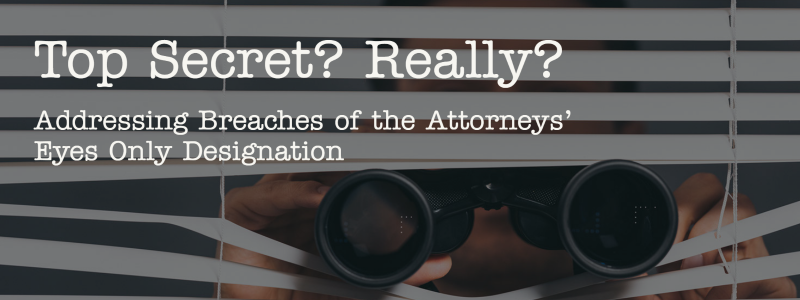
By Patrick H. O'Neill III and Elliot Moormann
Picture this: you’re involved in a contentious business dispute. You receive a voluminous document production from the opposing party after a prolonged meet-and-confer process. Much to your surprise, every single document has been marked “Confidential – Attorneys’ Eyes Only.” You report to your client that you’ve received thousands of documents, none of which she can review for herself and all of which need to be reviewed and cataloged. How can your client understand the merits of the claims or assess the case’s value if she cannot review the evidence provided by the opposing party?
In almost every commercial dispute, one of the first tasks completed in the discovery process is the stipulation to and entry of a protective order. The protective order is meant to serve the noble purpose of allowing the parties and the court to exchange and receive commercially significant information about trade secrets or other proprietary information for the purposes of litigation, while ensuring that such information is not used outside the context of the specific lawsuit. Almost every protective order allows parties to designate documents that are confidential or propriety as “confidential,” meaning they can be shared amongst the lawyers, the court, and the parties themselves. The majority of protective orders also include a provision that allows the “confidential” designation to be supplemented with the “attorneys’’s eyes only” designation to certain highly confidential information not to be shared with even the other parties to the litigation. Generally, the “Attorneys' Eyes Only” (AEO) designation is understood to be appropriate only in cases involving trade secrets, patents, or other intellectual property rights.
Like all discovery devices, a protective order, specifically the AEO designation, can be abused in a manner that frustrates the discovery process and increases the costs for all involved. How can you avoid and address abuses of the AEO designation?
First, understand the purposes of the protective order and your duty of good faith. Courts have long held that there is an “implicit duty of good faith in Rule 26(c) and the designation of documents under a protective order.” CellTrust Corp. v. ionLake, LLC, No. 19-CV-2855 (WMW/TNL), 2022 WL 1553558, at *3 (D. Minn. May 17, 2022). The vast majority of protective orders include specific language expressly requiring that any designation—be it confidential or AEO—be based on a “good faith determination” by the producing party. Making this duty of good faith clear from the protective order itself and recognizing that duty at each stage of discovery should, in theory, prevent outright discovery abuses.
Like all discovery devices, a protective order, specifically the AEO designation, can be abused in a manner that frustrates the discovery process and increases the costs for all involved. How can you avoid and address abuses of the AEO designation?
Second, get it right the first time. As the court in CellTrust made clear, “the duty of good faith in the protective order is a duty to review the documents in good faith before designating them as AEO.” Id. (quoting Paradigm Alliance, Inc. v. Celeritas Techs., LLC, 248 F.R.D. 598, 605 (D. Kan. 2008)). In other words, take care to make appropriate designations in the first instance, rather than relying on the meet-and-confer process to make necessary redesignations. Oftentimes, courts view wholesale or substantial redesignations through the meet-and-confer process as “too little, too late.” Humphreys v. Regents of Univ. of Cal., No. C-04-03808 SI (EDL), 2006 WL 3020902, at *3 (N.D. Cal. Oct. 23, 2006). See also Callsome Solutions Inc. v. Google, Inc., No. 652386/2014, 2018 WL 5267147, at *5 (N.Y. Sup. Ct. Oct. 23, 2018)(finding that a “wholesale de-designation confirms that Google's initial designations were not made in good faith…[and a] slow trickle of corrections does not rectify initial improper designations.”).
Third, if necessary, seek relief from the court to address abuses of the protective order. Courts are well aware of logistical restraints that come with abuse of the AEO designation, including issues related to every attorney’s duty of reasonable communication with their client under Minn. R. Prof. Cond. 1.4. A growing body of case law specific to the overuse of the AEO designation is replete with authority supporting a motion for discovery sanctions. Courts often focus on the content of specific documents marked AEO as well as the overall percentage of documents produced versus those designated AEO. See CellTrust, 2022 WL 1553558, at *5 (noting that “courts have condemned parties who have designated” a significant percentage of documents AEO).
The discovery process is meant to ensure disputes are decided on the merits. Effective use of a protective order plays an important role in allowing litigants to exchange sensitive information. However, overuse or abuse of aspects of the protective order frustrates this process and may give rise to sanctions.
Patrick H. O’Neill III, an associate attorney at Larson King, focuses his practice on commercial disputes, employment litigation, and professional liability claims. Before joining Larson King, Pat clerked at the Minnesota Court of Appeals after attending the University of St. Thomas School of Law.
Elliot Moormann is a Law Clerk at Larson King and a recent graduate from Mitchell Hamline School of Law. Elliot is passionate about all aspects of litigation and its forever changing landscape. Elliot received his undergraduate degree in Neurobiology and Philosophy from The University of Wisconsin Madison.